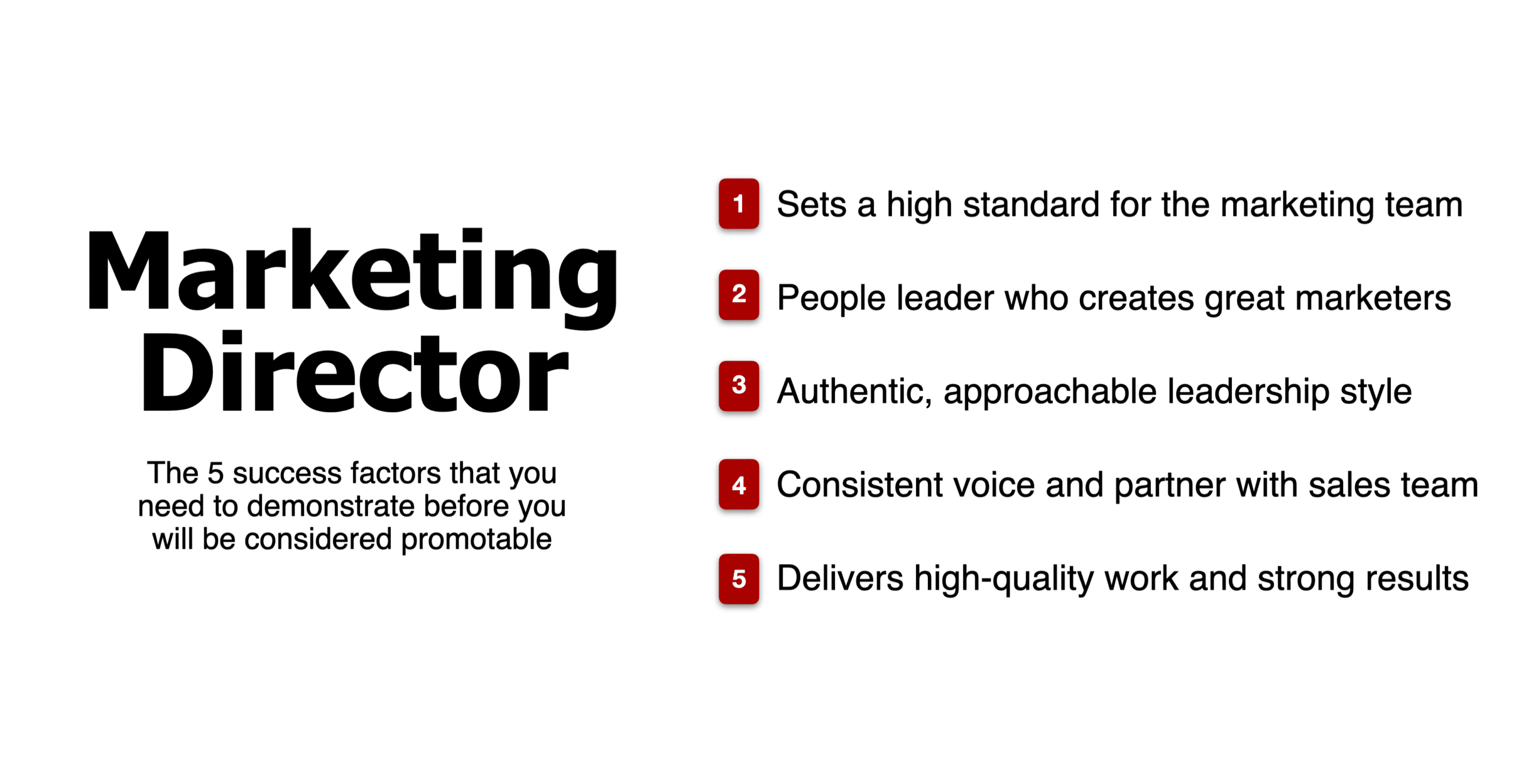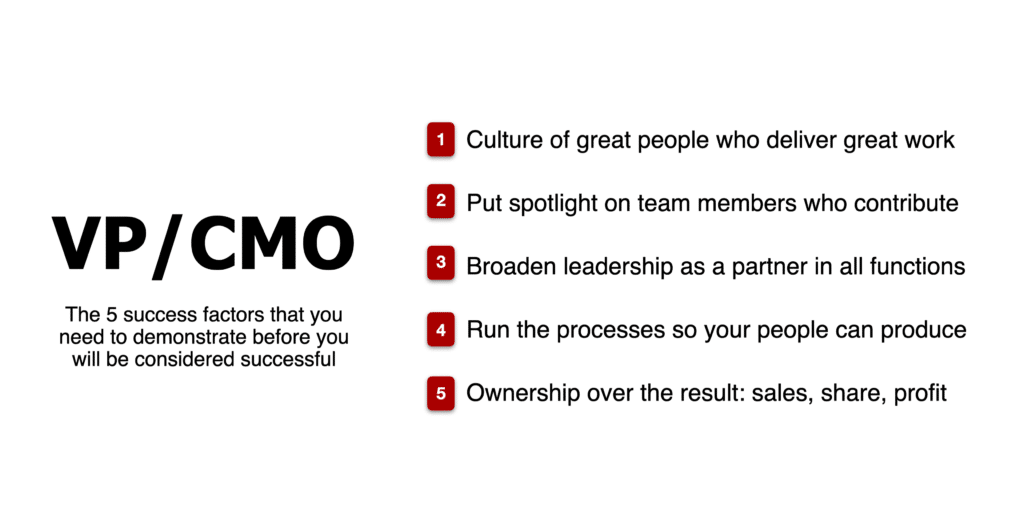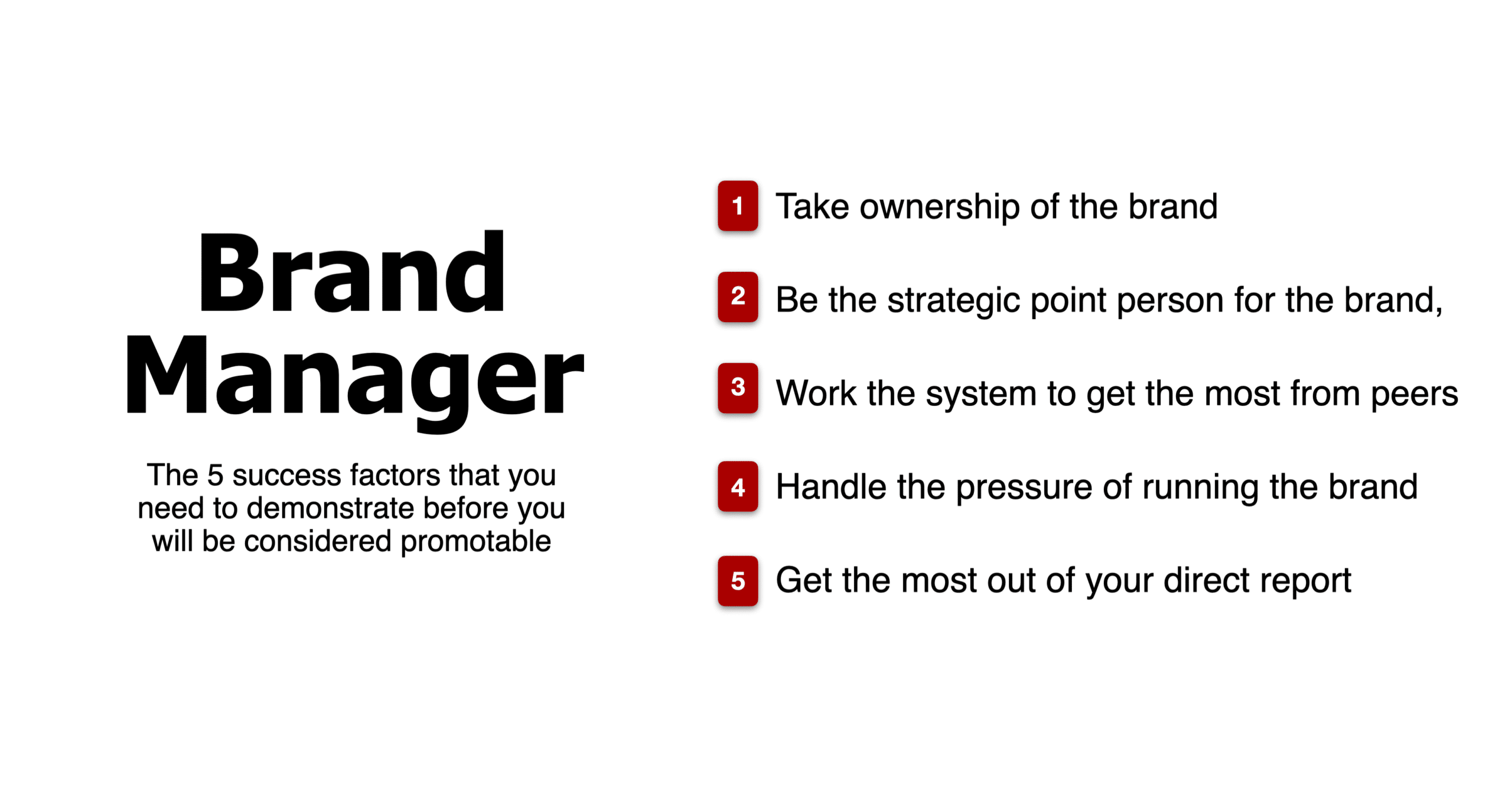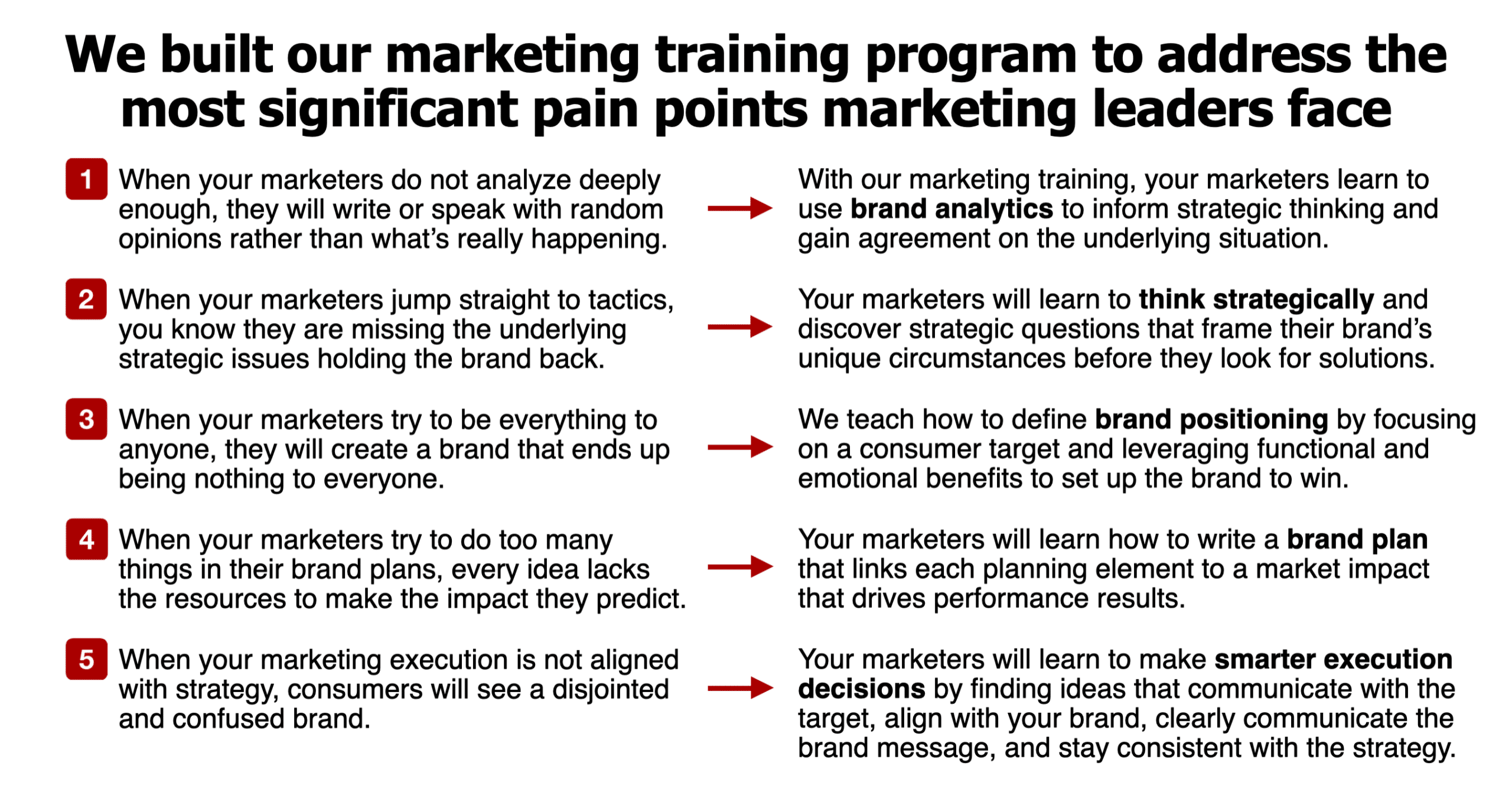At every level of your marketing career, you have to adjust to the new role. Brand Managers fail when they keep acting like Assistant Brand Managers, Directors fail when they keep acting like Brand Managers, and VPs fail when they don’t know what to do. On a classic marketing team, the four key roles are Assistant Brand Manager, Brand Manager, Marketing Director, and the VP or Chief Marketing Officer (CMO). Our goal is to help you achieve your full potential in your brand management career.
“At what level in my marketing career will my job finally be 100% strategy?”
That’s a question I had from someone who was going into their first marketing role. I thought about it briefly and said: “Well, never.”
Marketing Careers
On a classic brand management team, there are four key levels:
- Assistant Brand Manager.
- Brand Manager.
- Marketing Director or Group Marketing Director.
- VP Marketing or CMO.
In simple terms, the Assistant Brand Manager role is about doing, analyzing, and sending signals you have leadership skills for the future.
At the Brand Manager level, it becomes about ownership and strategic thinking within your brand plan. Most Brand Managers are honestly a disaster with their first direct report and get better around the fifth report.
When you get to the Marketing Director role, it becomes more about managing and leading than it does about thinking and doing. To be great, you need to motivate your team’s greatness and let your best players do their absolute best.
And finally, at the CMO level, you must create your own vision, focus on your people to make them better and shine, drive the business results, and run the processes.
Marketing careers path
For each role, our marketing career game plan has five factors of success, which your boss will need to see in the person before they are willing to promote them to the next level.
The list is cumulative, in that once you can demonstrate one of the success factors, you will need to keep improving on that skill at every level. Early on, it is all about trying and repeating every new task. As you move up in your marketing career, you need to keep working on tweaking, improving, and perfecting. Explore our Brand Management Mini MBA if you want to improve your skills.
Assistant Brand Manager
In simple terms, the entry-level of a marketing career is the Assistant Brand Manager (ABM) role. What you learn in the ABM role provides a foundation and discipline you will use throughout your career as you learn to turn data into analytical stories, take action before being asked, learn to make it happen through others, speak out to challenge the strategy, and be accountable for your work. The role can feel frustrating, as the amount of learning may diminish your creative instincts, but you must fight through the struggle.
My advice to the new Assistant Brand Manager
The most eager first-time marketers want to change the world. The role is a reality check where you learn before you can run. Too many new marketers want to focus on strategy right away, but the ABM is a “doing” role. You will be executing programs, analyzing results and learning how to be a project manager. Through the execution, send signals you are capable of thinking and leading in the future.
What separates the average from the great ones that get promoted? The best seem to figure out the right thing to do and then make it happen. Some figure out the right thing to do but struggle to work the system to make it happen. Others can work the system, but they forget to think through what is the right thing to do.
As you start your marketing career, the Assistant Brand Manager role can feel very frustrating. Many times, it will inhibit your creativity and even your ideas. Fight through it. It provides a foundation and discipline you will use throughout your marketing career.

1. Turn data into analytical stories
The Assistant Brand Manager role starts with a ton of data with market share results, tracking scores, or test results. Look for patterns or data breaks, ask questions, and start putting together stories. The analytical stories show you know what it means, help sell recommendations and support the action you will take. Never give a data point without a story or a recommended action, or you risk letting someone else (your boss) take your data and decide.
2. Take action before being asked
On day one, your manager will set most projects for the Assistant Brand Manager. When you are new, it is comfortable to wait for your projects. But don’t get in the habit of waiting for someone to create your project list. As you mature, push your ideas into the system and create your own project list. Start making smart decisions independently, and communicate those choices with your boss. Don’t ask permission, but tell them what you want to do and look for the head nod. Know what’s in your scope and align with your manager.
3. Make it happen through others
Instead of just functionally managing the steps of the project, find ways to make each project better, faster, or deliver more significant results. You need to understand each critical milestones to hit and manage bottlenecks. Every marketer meets resistance; the best knock can down those resistance points.
Figure out the task with the longest completion time and the most important element, as both will impact the entire project. You will need to push people to get things done. It would be best if you found a bit of magic by inspiring people to give their best ideas, put in their best effort, and deliver their best work.
4. Speak out to challenge the strategy
The Assistant Brand Manager must stay on strategy. Show you are always thinking, and feel confident in your strategic thoughts. Avoid just falling in love with an execution tactic that is not aligned with your brand’s strategy. Getting lost in your own “cool” projects is so easy. Ask the right questions. Challenge the strategy to make sure you understand. Silent marketers never last. Show you are always thinking, and feel confident in your strategic thoughts.
5. Be accountable for your work
Accountability is the first stepping stone to ownership, which sends a signal you are ready to be a Brand Manager. You have to find the right balance by motivating experts to give their best and knowing when to step in to avoid letting things slip or miss. Never allow your team to get stuck. Stay on top of timelines and lead your project teams. Be action-oriented and solution-focused. Be the hub of communication for all team members, and keep your manager aware.
Brand Manager
You still have to execute at the Brand Manager level, but with your first direct report, you now take on your first opportunity as a manager. The success factors for brand managers include learning to take ownership of their brand, provide strategic direction, continue to work the system, handle pressure and get the most out of their direct report.
1. Take ownership of your brand
As you move through your brand management career, this is a crucial step for you. Many new brand managers will struggle with the transition from being the helper to now being the owner. No one will hand you a project list. Not only will you make the project list, but you will also come up with the strategies that set up the need for the projects.
Balance using an asking voice with a telling voice. Prior to a decision, ask as many probing questions to understand what your experts know. Once you feel comfortable with your direction, your experts want you to decide. They want to be heard and have their expertise recognized. But, they know they recommend and you decide.
When managing upwards, be careful you don’t ask your boss what you should do. A great boss will want you to tell them what you want to do, and let the debate begin from there.
2. Able to provide strategic direction
It is time for you to start to visualize a clear vision and lay out a set of aligned strategies. Your vision becomes the stake in the ground and serves as a rallying cry for your team. Let everyone know where you want to go. As we discussed in our strategic thinking and brand plan chapters, everything you do should match up to your vision. The key issues address what is in the way of your vision. The strategies map out options for how to achieve your vision. And, every tactic and execution needs to be aligned with your vision. Anything that is off must be rejected.
At this stage of your brand management career, you become the steward of the strategy. Build strategies that allow you to steer, control, inspire, and manage the various functions and agencies that support your brand. Make it clear through your plans. Use our one-page plans to keep everyone aligned. Even with a wide-ranging collection of people behind the brand, you are the one who will make sure their agenda matches up to your brand strategies.
3. Know how to work the system
The best brand managers know what they want, and then go get what they want. At junior levels, every organization appears to be a collective mess, filled with functional groups, layers of personalities, and agencies. Everyone brings a different set of goals and motivations, appearing to resist everything you want. As you gain more experience, you will begin working that system to your advantage. Get to know your experts, listen to their issues, and tap into everyone’s unique motivations to ask for their best work.
One secret that took me many years to figure out: If you want someone’s best work, ask for it. The reason it works is very few ask. When you say, “This is a crucial project, and I will really need your best,” you hit the right nerve that connects with their ego to deliver greatness on your behalf. This skill will help you throughout your brand management career.
4. Achieve success while dealing with pressure
The unknown of ambiguity and the time pressure of deadlines can work against each other. Figure out how to work them to our advantage, as they evoke the right balance of patience with ambiguity and persistence in getting things done. Be organized, disciplined and work the system, so it does not get in your way.
Another significant pressure at this stage of your brand management career is when the results do not come in. It can be frustrating but is a reality we face. Force yourself to course correct, re-examine the underlying issues, and regroup with your team to look at other options, rather than continuing to repeat and repeat and repeat.
There is pressure in relationships that many Marketers feel, but are unable to fix. Be pro-active in making the first move to build a relationship. Try to figure out the motivations and frustration points in those you work with before they become a problem. Common ground is usually not that far away. At this level, you must demonstrate you can handle the pressure of a leadership role. The four pressures include ambiguity, time management, relationships, and results.
The unknown of marketing can be stressful
Marketing is filled with ambiguity, and the inability to deal with it will eat you alive. Will this ad work? Will the buyer like this idea? Can we increase our forecast for our Q3 promotion? There are so many unknowns until they are known. As the leader, you have to stay comfortable with the unknown to let it play out, because if you panic, you will back the team into an inferior answer.
The daily pressure adds up.
When it comes to time pressure, show up organized, disciplined, and work the system, so it doesn’t get in your way. The pressure of ambiguity gets exponential when it conflicts with a time pressure. If you can figure out how to work time and ambiguity together, you can apply the right time pressure to get your experts to provide their best answers. It can be a dangerous game, as you may risk panicking your team. But, when played well, you can get the best from your team.
People relationships add stress.
As you move up through your marketing career, you will feel the relationship pressure when leading many cross-functional peers, who may be significantly older and more experienced than you are. Be pro-active in building the relationship. Try to figure out the motivations and frustration points in those you work with before they become a problem. Know where someone stands before you can figure out where you can move them. Common ground is usually not that far away.
The pressure for results.
Another significant pressure is when positive results don’t come in. It can be frustrating, but it is a reality we all face. Force yourself to course-correct, rather than getting fixated on your one answer. Step back, reexamine the underlying issues, and regroup with your team to look at other options, rather than continuing to repeat and repeat and repeat. The pressure for results will increase at each level of your brand management career.
5. Managing others
From my experience, most new brand managers struggle with their first five direct reports. With each new report, look to tweak and improve your management style. At first, you bring your biases of how you wish you were treated. That works for you, but it might not work for your direct report.
Be flexible so that you can adjust your management style. Keep self-evaluating and looking for ways to improve with each direct report.
You will struggle with shifting from “do-er” to coach. It will always tempting do it yourself in five minutes, rather than spend an hour to show your new ABM. Be the manager who gives feedback. I see too many brand managers not giving enough feedback. I have always been amazed that even those who thrived with feedback as an ABM leave their direct report to squirm. Many are afraid of “going negative,” so the ABM is left in the dark or believe they are doing a good job.
Take the time to teach up front, give the Assistant Brand Manager some room to try it out, and then provide hands-on feedback in real time. Use weekly meetings to give both positive feedback and address gaps.
Marketing Director
When you get to the Marketing Director role, it becomes more about managing and leading than it does about doing. To be great, you need to motivate the greatness of your team and let your best players do their absolute best. Let your team execute. Your role is to oversee and challenge but to let them run their brand. The priorities shift from marketing skills into becoming a consistent leader. Your consistency starts with learning how to set a consistently high standard for your team. You need to become predictable and consistent, a consistent people leader, a consistent voice to your sales team, and you consistently deliver great work and strong results.

1. Set a consistently high standard for your team
Hold your team to a consistently high standard of work: Rather than being the leader by example, I’d rather see you establish a high standard and hold everyone and yourself to that standard. Shift your style to a more process orientation so you can organize the team to stay focused, hit deadlines, keep things moving and produce consistent output. Consistent quality of brand plans, execution, and interactions with everyone. It’s about how to balance the freedom you give with the standard you demand. Delegate so you motivate your stars, but never abdicate ownership of how your overall team shows up.
2. Behave predictably and consistently
A great marketing director becomes the consistent voice of reason to any potential influencers, acting on behalf of the brand team. The director becomes the usual point person that the VP, sales team, agency, each turn to offering their thoughts on the brands. Yet the director has to allow their BM to own the brand. As the team’s voice of reason, a great marketing director must continue to ground all potential influencers in the brand plan with the strategy choices, consistently communicate the brand’s direction and back up any tactical choices being made by the team.
3. Be a consistent people leader
Newly appointed directors have to stop acting like a “Senior-senior brand manager” and let your team breathe and grow. We know you can write a brand plan, roll out a promotion super fast and make decisions on creative. But can you inspire your team to do the same? It becomes the director’s role to manage and cultivate the talent. Most brand managers have high ambitions–constantly wanting praise, but equally seeking out advice for how to get better. Be passionate about people’s careers–anything less they’ll see it as merely a duty you are fulfilling. A great marketing director should be meeting quarterly with each team member one on one to take them through a quarterly performance review. Waiting for year-end is just not enough.
4. Show up as the consistent voice to the sales team
Marketing directors become the go-to marketing person for the sales team to approach. Great sales people challenge marketers to make sure their account wins. I’ve seen many sales teams destroy the marketing director because the director refused to listen and stubbornly put forward their plan without sales input. Be the director that consistently reaches out and listens. They’ll be in shock, and stand behind your business. If salespeople feel they’ve been heard, they are more apt to follow the directors vision and direction. A great marketing director should informally meet with all key senior sales leaders on a quarterly basis, to get to know them and listen to their problems. This informal forum allows problems to bubble up of problems and be heard, before they become a problem.
5. Consistently deliver great work and strong results
As it is a business, a great marketing director is expected to make the numbers. They have a knack for finding growth where others can’t. And yet when they don’t, they are the first to own the miss and put forward a recovery plan before being asked.You must have an entrepreneurial spirit of ownership, create goals that “scare you a little but excite you a lot”. They reach out for help across the organization, making those goals public and keep the results perfectly transparent. And everyone will follow you.
Consistency matters
Hopefully, you noticed the word “consistent” show up in all 5 factors for success. At this pointing your marketing career, you want to establish your style and then find ways to stay consistent. That is a trait I would encourage every director to take: show up with consistency in standards for your team, strategy, people management, dealings with sales, and owning the numbers. With a bigger group of people who you influence, with a broader array of interactions across the organization, and with a bigger business line on the P&L, anything less than consistent will rattle your core team and rattle the system built around you. No one likes an inconsistent or unpredictable leader. They will mock your mood swings in the cafeteria. You will become famous but for the wrong reasons. The sales team will not be able to rely on your word–and to them, that’s everything.
Senior leaders will struggle with you–and will not want to put you on the big important business because it just feels risky. Your agency will be uncertain as to what mood you will be in, when you show up to meetings. With your maturity and experience, now is the time to start to craft a consistent version of what you want to be.
Chief Marketing Officer
As you move up to the Vice President of Marketing or Chief Marketing Officer (CMO), you will notice the shift you must make from marketing to people. You still manage your direct reports, but you will add the leadership of a larger marketing team. Essentially, you will be the spokesperson for marketing to every function and every agency. Most importantly, you need to realize the smarter your people, the better the work they produce—and the better results you all achieve. Challenge the marketing execution, with oversight, but let your team execute.
The best VPs and CMOs realize they never do it alone. Everything you do is through the greatness of other people. Your people come first. Bring a vision to the role, put the spotlight on your team, be an approachable leader, and run the process and the numbers to ensure your people can focus on delivering what needs to happen. Keep your team focused, challenged, and inspired. Invest in your people and you will see the difference.

1. Your people come first
What many people miss is that people come first. At the VP Marketing and CMO level, I believe if you focus on your people, and the results will come. Smart people produce great work and in turn, outstanding results. It would help if you had a regular review of the talent with your directors. Build a system to provide feedback to everyone on the team, preferably quarterly.
Invest in training and development
Marketing Training should not be just learning on-the-job, but in the classroom, to challenge the thinking of your people and give them added skills to be better in their careers. Marketing fundamentals matter. Your people need to know how to strategic thinking, define their brand’s positioning statement, write a Brand Plan, write a Creative Brief, and judge advertising. Marketers are NOT getting the same development they did in prior generations. Investing in training, not only makes them better, but it also motivates them to know that you are investing in them.
2. Run the process and the system
The best VP of Marketing or CMO should run the P&L and all the Marketing processes. You have to run the P&L and make investment choices. Bring an ROI and ROE (Return on Investment and Effort) mindset to those decisions. These choices will be one of the essentials to making the numbers and gaining more freedom in how you do the job. Regarding the process, I have always believed that smart processes in place—brand planning, advertising, creative briefs—should not restrict your people but instead provide the right freedom to your people. Get your people to drive all their creative energy into great work that gets in the marketplace, not trying to figure out what slide looks cool in the brand plan presentation.
3. Be the visionary
The best VP of Marketing or CMO brings a vision for the brand’s direction and the team’s inspiration. Create a theme that taps into the purpose, beliefs, expectations, and behaviors you will reward. You are now the Mayor of Marketing. What’s your campaign slogan? Get up, walk around, and engage with everyone on your team. You can make someone’s day, motivate and encourage them to deliver excellent work. Set a high standard, and when your team put an outstanding idea up for approval, and it is fundamentally sound, then approve it. Do not do the constant spin of fear. It makes you look indecisive and bureaucratic.
4. Put the spotlight on your people
The best VP of Marketing or CMO lets their people own it and let them shine. It has to be about them, not you. Do not be the super-duper Brand Manager. By making all the decisions, you bring yourself down a level or two and take over their job. Instead of telling, start asking questions. Challenge your team and recognize the great work. It might be my own thing, but I never said: “thank you” because I never thought they were doing it for me. Instead, I said: “you should be proud” because I knew they were doing it for themselves.
5. Be a consistent, authentic, approachable leader
The best VP of Marketing or CMO has an open door and makes it easy for people to engage them. You have to set up an avenue where they can approach you and feel comfortable enough to communicate the good and bad. A hidden leader scares people. No one wants to share concerns or bad results for fear of how you will react. Don’t get left in the dark. Open communication keeps you more knowledgeable. Get your people to challenge you. Inconsistent and unpredictable behavior by a leader does not “keep them on their toes.” It creates tension and inhibits creativity.
Be consistent in how you think, how you act in meetings, and how you approve. Leadership assumes “follower-ship.” Create an atmosphere that will make people want to go the extra mile for you. Once you show up ready to listen, you will be surprised how honest they will be and how much they will tell you.
Leadership
Your focus must change as you move up in your brand management career
While the entry-level role of your marketing career is highly focused on execution, you will even learn elements of strategy and leadership while executing. The brand manager level adds in more management and increased leadership, but the still balanced with execution. At the director level, you begin to execute through others. And, at the VP and CMO level, the job shifts to becoming 60% about people, evenly split with management and leadership. Try to use this thinking as you manage your own brand management career.
To illustrate, click to zoom in on the brand management career pathway.

















